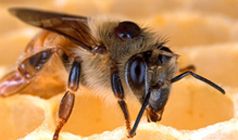 Photo by Scott Bauer, USDA Agricultural Research Service, Bugwood.org |
- External parasitic mites that feed on the haemolymph of both drone and worker bee larvae and pupae, and adult bees
- Detection possible by close examination of brood or testing of adult bees
- Symptoms include deformed pupae and adults (stunting, damaged wings, legs and abdomens), Parasitic Mite Syndrome and colony decline
- Varroa mites can also spread viruses, further affecting the colony’s health and disease susceptibility
|
High priority pest of: Honey bees, Almonds, Apples and pears, Macadamias
Scientific name: Varroa destructor and Varroa jacobsoni
EPPRD Category:
Life Form: Mites (ACARI)
Pest Documents
FS: fact sheet
CP: contingency plan
DP: diagnostic protocol






Recent Comments